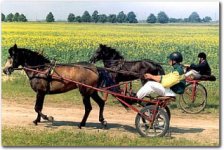♘امیرحسین♞
♘ مدیریت انجمن اسب ایران ♞
The Žemaitukas, Zhmud, or Zhemaichu (literally, 'little Samogitian') is a pony breed from Lithuania dated to the 6th century. It was used as a war horse by the Lithuanians during the Northern Crusades. Its origin is uncertain, but most studies point to its ancestry as a cross between indigenous breeds and the Konik, a Polish breed, which were both probably descended from the Tarpan. During the 20th century, Russian breeds influenced the Žemaitukas, as well as light Polish horses.
The Žemaitukas pony
The Žemaitukas pony
Arabian blood was added during the 19th century, giving the horse an Arab-type head, including the characteristic dish-shaped Arabian profile. The infusion of Arabian blood created two subtypes of the Žemaitukas: those with Arabian ancestry were considered suitable for riding, while the other, more closely related to the indigenous horses, was better adapted to farm work. After World War II, the distinction was muted. A deliberate effort was made to increase the size and bulk of the animals so that they could be used for both riding and draft work.
The ponies are said to be hardy, possessing excellent stamina and endurance, and displaying a willing temperament. It is now a multi-purpose breed; it is ridden, used in farm work, and crossed with lighter and larger breeds to produce sport horses.
The breed description states that "... The Žemaitukas has a fairly bulky frame. They have a broad, muscular neck set into a deep chest. The back is short and compact, the croup sloping, and the tail low-set. The shoulder is fairly upright. The legs are short and muscular with tough hooves, and the breed commonly has poor hocks."
The ponies are usually a dun color and often display the primeval dorsal stripe, but they may also be brown, bay, black, or palomino. The Žemaitukas generally stands between 13.2 and 14.2 hands (1.37 to 1.47 m) high, placing it among the taller pony breeds.
As with other domestic animals around the world, studies have been carried out on this horse's genetic heritage, since it may possess unique characteristics. The FAO Mission Conference for Central and Eastern European countries recognized the Žemaitukas as an internationally watched breed, and included it into the FAO World Watch List for domestic animal diversity. Maternal DNA sequencing indicated that one of its haplotypes is similar to an old haplotype present in horse breeds of the North European area.
The Žemaitukas pony
The Žemaitukas pony
Arabian blood was added during the 19th century, giving the horse an Arab-type head, including the characteristic dish-shaped Arabian profile. The infusion of Arabian blood created two subtypes of the Žemaitukas: those with Arabian ancestry were considered suitable for riding, while the other, more closely related to the indigenous horses, was better adapted to farm work. After World War II, the distinction was muted. A deliberate effort was made to increase the size and bulk of the animals so that they could be used for both riding and draft work.
The ponies are said to be hardy, possessing excellent stamina and endurance, and displaying a willing temperament. It is now a multi-purpose breed; it is ridden, used in farm work, and crossed with lighter and larger breeds to produce sport horses.
The breed description states that "... The Žemaitukas has a fairly bulky frame. They have a broad, muscular neck set into a deep chest. The back is short and compact, the croup sloping, and the tail low-set. The shoulder is fairly upright. The legs are short and muscular with tough hooves, and the breed commonly has poor hocks."
The ponies are usually a dun color and often display the primeval dorsal stripe, but they may also be brown, bay, black, or palomino. The Žemaitukas generally stands between 13.2 and 14.2 hands (1.37 to 1.47 m) high, placing it among the taller pony breeds.
As with other domestic animals around the world, studies have been carried out on this horse's genetic heritage, since it may possess unique characteristics. The FAO Mission Conference for Central and Eastern European countries recognized the Žemaitukas as an internationally watched breed, and included it into the FAO World Watch List for domestic animal diversity. Maternal DNA sequencing indicated that one of its haplotypes is similar to an old haplotype present in horse breeds of the North European area.

